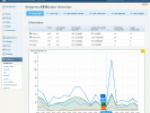I am not a full-time SEO specialist. I am mainly a developer and a web designer who is interested in SEO only to be able to build flawless websites for my clients. But I am also a blogger and I run a few projects of my own which I like to check on and if I have some spare time, to carefully polish them.
I have tried out many programs and services for SEO web status checking and some of them have stayed in my computer or as a bookmark in a web browser until this day. I noticed Sitebulb several years ago and it caught my attention because I thought it had a well-done user environment and an intelligible communicating of information. Data presentation is very important in SEO. I really don’t want to look at tables that remind me of the times of FoxPro.
This year I started to be more active in my various projects so it was the perfect opportunity to enrich my toolset with Sitebulb. Two-week trial version has convinced me so I have bought the program.

Why not a SEO online service?
Sitebulb combines good attributes of desktop SEO checking tools and established online services. Programs running on your computer have the advantage of not (usually) being limited to a certain number of websites you can check and monitor. But their interface doesn’t deserve even being looked at. On the other hand, online services are able to better manage bigger websites (at least some of them), they offer better arranged interfaces and reports. But when working with a larger number of websites, their rates climb sky-high.
The Pro version of Sitebulb costs 29 EUR excluding VAT a month and within single one audit can check up to half a million URLs. Compared to more expensive online services limited to 10 000 URLs it is an obvious choice. But if it is enough for you to check some smaller websites, Sitebulb offers a similar limit with its lower tariff for about half this cost.
Unlimited number of projects
The base of working with Sitebulb are projects. A project is basically a web you want to check and assess. Number of them is not limited, the data are being saved to your computer. For each project, a history of every audit is being saved and audits can be partially compared to each other. In the summary you can also see how much of your hard disk capacity have the project or audit data taken up.
Sitebulb crawler can a quick one without the JavaScript support or a slower one which launches JS and uses the Chrome core. When setting a project up you can also determine whether a web will be checked in its desktop or mobile version. It is also possible to set some more advanced features such as logging in to a web, language, user-agent etc.
The partial check of addresses is definitely interesting for larger webs because it can give you a quick overview of a web status. Usually, when you have repaired quantum of the problems that occur the most often and are the same for all the subpages, you will launch the complete check. With smaller webs you don’t think about it and just launch it every time.
Setting up the elements of a SEO audit
The list of things that will be checked by Sitebulb depends on the license version you have bought. The PRO version offers 315 items, the Lite version 138 items. No, we won’t be listing all the checked metatags and site attributes, that is practically the same for all SEO tools, I want to mention the most interesting points:
- Structured data and their validity against Schema.org
- Security, protocols, certificates
- AMP in case you still don’t think this technology is dead
- Accessibility. Useful to turn on at least once in a project for you to have some idea
- Connection to Google Analytics and Search Console that are able to extract keywords and their impact on traffic
- Extracting content from webs using CSS selectors. Similarly as Greenflare does it.
- Scheduled checking. Both one-time and repeated
In case of connection to Google services I appreciate that I can only confirm it once and then just pick which one belongs to the newly added project. With rival apps it is no exception to be forced to set this up again every week.
Regarding the scheduled checking function, Sitebulb has to be running at that time of course, it is not as convenient as an online service. Anyways on MacOS it takes up about 300 MB of the operative memory (when not active) which compared to the rival Website Auditor and its crazy usage of 1,5 GB is ridiculously low.
The result of a SEO audit and Sitebulb reports
While Sitebulb checks and scans a selected website, you can still work with it and browse through information - for example results of other project audits you saved before. With web apps this function would be taken for granted but with desktop competition – not so much.

Results of an audit reflect the turned on parts of the check you have set up in a project. It can differ from audit to audit which I find quite useful. So if you during one audit run don’t turn on the accessibility check, then it just will not be visible in the results. I recommend to go through the Sitebulb settings very thouroughly because you might be surprised what can be revealed as it is not always obvious that it’s a possible thing to do.
The basic view of an audit result shows diagrams containing numbers of checked URLs, types of content (HTML, CSS, images), site depth and other. The most interesting feature for you probably will be a recommendation in the Hint part where, using five levels of importance, it will be shown what you should improve on your website. From non-functioning links, missing metatags, image problems to (for example) sites that according to Google Analytics have no traffic at all.

There are also the standard lists of addresses – a list of all on a web and also the of ones that show a particular problem. You can easily export them to CSV and send them to be further processed. I personally quite often use the export of problematic links where are of course included those pages on which the link can be found. Except the CSV export it is possible to create summarizing reports in PDF.
In the side navigation you can switch between parts of the check and partial recommendations connected to a specific area. SEO, security, accessibility, viewing on phones etc.
Sitebulb can also view the results of measuring the new Web Vitals for individual addresses located on a web. Which comes in handy because nobody wants to browse through one site after another and move it to Lighthouse manually. It is just necessary to set up Chrome as a crawler.

Will Sitebulb help you with the traffic analysis?
Sitebulb is mainly a tool for checking the web status from the SEO point of view. It is not primarily a tool for tracking a web position in search engines. If you connect it to Google Analytics and Search Consoli, it will offer some sources for further work even for the purpose of web keyword optimalization.
What caught my attention is distinguishing the summaries - the information about keywords will be viewed in an overall summary or according to the traffic from desktops or mobiles. Sitebulb is able to filter out the keywords containing the name of your brand into a separate overview if you set them up in a project.

The overview itself probably will be familiar to you from Search Console. Or it should be. It views web URL address, the keyword under which it appears according to the Google search results data, an average position in searching, number of clicks and number of views in SERP. This way you can easily evaluate which sites that have already appeared in the search results deserve your attention in order to gain the largest meaningful traffic for your web.

Search Traffic overview is my favorite space where I can easily find out which sites are not visited from search engines at all. And that might not be alright, but it can be. It depends on the context. Don’t be fooled by the fact you can see a screenshot with a zero in the overall number of views in case of some sites. It means viewing in the Google search results. Standard PageViews is located a few columns towards the back. People not viewing a site from a search engine does not mean they will not open them separately when visiting the web.
Particularly Search Traffic is an example of function where Sitebulb views a lot of data that sometimes are not needed for the desired purpose. Luckily developers have thought about this and so you can easily adjust individual overviews. You can edit viewing of individual columns, you can turn them off or rearrange them.

Do I miss anything?
At the moment I am in the phase when I still from time to time discover some new nook which Sitebulb offers for SEO audit. I also like its online documentation very much. It is really well-arranged and unlike common helps it is worth to take a look in it. If I were to choose at least one thing I would improve in Sitebulb, it would be the audit comparison.
SItebulb is able to compare audits but it only applies to some partial technical issues. Regarding traffic it also offers a basic comparison using numbers with a notification informing you what has improved or gotten worse. But I would like to see the keyword data comparison from Search Console. Whether the web was able to get to a better average position, for example. But I understand that this is not the primary goal of Sitebulb. So for this purpose I continue to use Rank Tracker from Link-Assistant.com.
It is worth the investment
From my perspective it is worth to pay 425 USD per year for Sitebulb Pro. Of course this is true in case you will actively use it and you will use the advice that it will provide you with. I use it also for creating some simpler reports for my clients. Right now it contains twenty projects.
There is also a Lite version for 180 USD/year. You can also check Sitebulb Cloud which you use use remotely.
Sitebulb alternatives
Let’s quickly look at rival programs and SEO audit services.
Screaming Frog SEO Spider – well-known benchmark for SEO tools. Free basic version with a limit, a one-year license costs about half. It is able to do basic checking and analyses, I don’t like its tabular design. It is multiplatform, like Sitebulb it runs on Windows and MacOS and in addition to these on Linux, too.
Website Auditor – one of the programs in the toolset from Link-Asistant.com. It is a standard solution full of tables. It requires Java just like Screaming Frog and that is mirrored in a fact that this app demands a lot from your memory. The whole set is more expensive but besides similar information it can offer also tools for monitoring search engine position, checking and searching for backlinks and other SEO stuff. I bought it a year before Sitebulb and now I am using both simultaneously.
Semrush – An online service executing SEO audit and a regular check of your webs, but also monitoring positions in search engines, backlink analysis and help with gaining them. Regarding the price, it is absolutely not comparable to Sitebulb, the basic version for five webs costs more than 1,199 USD a year with a limit of five projects. On the other hand their marketing department will be happy to offer you some substantial discounts when using a trial version.
Ahrefs – probably the most popular online SEO service, especially connected to backlink monitoring. Starting on 984 USD a year it has no project limit but the overall number of addresses is limited to 10 000. This does not include only pages but also images and other sources. If you don’t spend all of your days with SEO it might be a little too expensive. But last year they launched a completely free Website Checker that can do a basic web audit. I use it as an additional tool. I don’t have to think about checking and it can view basic results of all my webs on one notice board which Sitebulb or other desktop tools cannot do.







